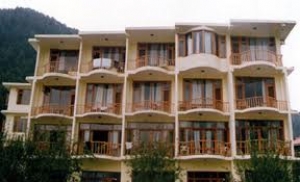Solang Valley (2480 m) offers scenic view of snow-white crests and tall cedar trees. It serves base camp for several treks. It is also the venue of State & National level winter sports.
Kothi village bids an excellent view of mountains. There is a ravine 400 feet deep and 2 km long, which is to be crossed to enter the village.
Gulaba is situated about 20 km from Manali. Beautiful flowerbeds cover the area giving the feel of paradise.
Rohtang Pass (4111 m).Grandeur of the mountains is at its peak here. 'Rohtang' in Tibetan language means a house of corpses. The name perhaps owes its origin to the chain of accidental deaths that occurred here from time to time. Weather here is unpredictable. The pass remains open from early June to mid - December.
Hadimba Devi Temple at Dhungri, Manali contains idol of Hadimba installed on a rock, which is inside the temple. It is believed that she used to meditate sitting on it. Local people worship her as goddess Durga. This temple built by Raja Bahadur Singh in 1553 AD has been constructed in pagoda style.
Club House: 1.5 Km from Manali town, at the end of old Manali village, this club house with its comprehensive facilities of a roller skating rink , an auditorium, a billiards room, a card room, a library and a bar with restaurant makes a wonderful outing for holiday elites.
Manu Temple: Manu Rishi temple, 3 km from Manali, is a beautiful structure with a five- storey pagoda type of roof and a brass 'Kalasa' crowning the top. The temple is dedicated to sage Manu from whom human race is believed to have started. This land was known as 'Land of Manu' and was later renamed Manali after him.
Gadhan Thekchokling Gompa Manali, is a newly built one. The monastery runs a Thangka school of arts and a carpet-weaving centre. This is done mainly to preserve ancient Tibetan art. Articles of handicraft are also kept for sale to outsiders. The paintings inside depict events from Lord Buddha's life. The Kalchakra i.e. the wheel of life painted on the wall of the monastery shows the circle of life.
Jagatsukh: Situated 6 km from Manali on the way to Naggar, Jagatsukh is famous for old temples like the 18th century Gauri Shankar temple and Sandhya Gaytari temple. The Chacholi fair held annually is a must see event.
Roerich Art Gallery Naggar preserves original works of Roerich on the Himalayas, quotations from Roerich and valued words of the visitors and the admirers.
Uruswati Himalayan Folk Art Museum, Naggar. Uruswati, meaning light of the morning star. This folk art museum was founded by Professor and Madame Nicholas Roerich in 1928, then known as Research Institute, Naggar where history, ethos, the spirit of the Himalayan region and the traditional Indian and Tibetan medicines were studied. It was renamed as Uruswati Himalayan Folk Art Museum in 1993. The museum preserves paintings made by Roerich and also those made by Indian and Russian artists.
Naggar Castle, the only extant fortress was built during Raja Sidha Singh's reign more than 500 years ago. Stones used were brought from a fort situated on the other side of Naggar.
Vaishno Devi Temple: Vaishno Devi Temple lies on the National Highway about 2 km north of Kullu town. This newly founded temple is as famous as any other old temple. Mahadevi herself wished for this temple and secondly it is blessed by two Tapasyas, one of Mahadevi (Vaishnu Devi) herself and other of Shri Maharaj ji (founder).
Bijli Mahadev temple is built in Pahari style. The temple has a shivlingam installed in it. It is situated on top of a hill, 14 km from Kullu at a height of about 1924 m.
Manikaran is situated in Parbati valley at a distance of 45 km to the northeast of Kullu. Manikaran is well known for its hot water springs, Sikh Gurudwara and Ram temple. Manikaran also leads to various popular trek routes, as those to Malana, Pin Parbati, etc.















